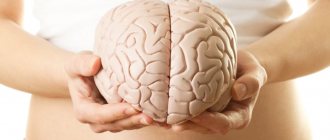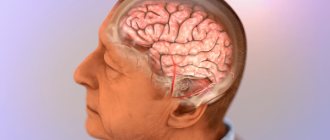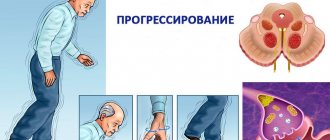Appointment with a psychiatrist at the psychiatric clinic sch.clinic +7
Dementia with Lewy bodies is characterized by chronic impairment of cognitive functions with the appearance of intracellular inclusions, called Lewy bodies, in the cytoplasm of neurons in the cerebral cortex.
Dementia in Parkinson's disease is a cognitive disorder characterized by the formation of Lewy bodies in the substantia nigra; it develops late in Parkinson's disease. Dementia is a chronic, usually irreversible, decline in cognitive function that affects all aspects of cognitive activity.
Dementia with Lewy bodies is the 3rd most common type of dementia. The onset of the disease usually occurs over 60 years of age.
Lewy bodies are spherical, eosinophilic, cytoplasmic neuronal inclusions composed of aggregates of the synaptic protein alpha-synuclein. They are found in the cerebral cortex of patients with primary dementia with Lewy bodies. With this disease, the levels of neurotransmitters change and neuronal connections between the striatum and neocortex are disrupted.
Lewy bodies are also found in the substantia nigra of patients with Parkinson's disease, and dementia (Parkinson's disease dementia) may, in some cases, develop later in the course of the disease. About 40% of patients with Parkinson's disease develop Parkinson's disease dementia; which is usually discovered at the age of 70, and 10-15 years after Parkinson's disease was diagnosed.
Because Lewy bodies are present in both dementia with Lewy bodies and dementia Parkinson's disease, some experts believe that both disorders may be part of a generalized synucleinopathy affecting both the central and peripheral nervous systems. Lewy bodies can also sometimes be detected in Alzheimer's disease, and in patients with dementia with Lewy bodies, the formation of neuritic plaques and neurofibrillary tangles is also observed in some cases. Thus, to some extent, Lewy body dementia, Parkinson's disease and Alzheimer's disease share common features. Further research is needed to clarify these relationships.
Both types of dementia - with Lewy bodies and dementia with Parkinson's disease - have a progressive course with a poor prognosis.
Dementia should not be confused with delirium, although cognitive function is impaired in both conditions. The following features usually help distinguish dementia from delirium:
- Dementia primarily affects memory, is usually caused by anatomical changes in the brain, has a slower onset and is usually irreversible.
- Delirium primarily affects attention, usually occurs during acute illness or as a result of toxic exposure (sometimes life-threatening), and is often reversible.
Other characteristic features also help differentiate dementia from delirium (see Differential Diagnosis of Delirium and Dementia*).
Clinical manifestations
Dementia with Lewy bodies
The initial decline in cognitive function in dementia with Lewy bodies resembles that in other dementias; it includes declines in memory, attention and executive function, as well as behavioral problems.
Extrapyramidal symptoms develop (usually including rigidity, bradykinesia, and gait instability) (see also Overview of Movement and Cerebellar Disorders). However, in Lewy body dementia (unlike Parkinson's disease), cognitive impairment and extrapyramidal symptoms develop in the first year of the disease. Also, extrapyramidal symptoms differ from those in Parkinson's disease; In dementia with Lewy bodies, tremor does not develop in the early stages of the disease; axial muscle rigidity and gait disturbances occur earlier, and symptoms have a symmetrical distribution. Repeated falls are common.
Fluctuation of cognitive function is a relatively specific symptom for dementia with Lewy bodies. Periods of the patient being active, with adequate behavior and orientation, may be followed by periods of confusion and lack of response to questions asked, which usually last for days or weeks, but then again give way to the ability to make contact.
Memory deteriorates, but the deterioration is manifested to a greater extent due to a lack of alertness and attention than memory itself; thus, short-term response is less affected than digit span memory (ability to repeat 7 digits forward and 5 backwards).
Patients may stare at one point for a long time. Excessive sleepiness during the day is common.
Visuospatial orientation and visuoconstructional ability (block tests, drawing a clock, or copying shapes) are more affected than other cognitive functions.
Visual hallucinations are a characteristic and often life-threatening manifestation of the disease, in contrast to benign hallucinations in Parkinson's disease. Auditory, olfactory, and tactile hallucinations are less common. In 50–65% of patients, delusions occur that are complex and bizarre in nature, which distinguishes it from simple delusions of persecution in Alzheimer's disease.
Autonomic disorders often develop with the occurrence of unexplained fainting conditions. Autonomic disturbances may occur simultaneously with the onset of cognitive deficits or shortly after their onset. Hypersensitivity to antipsychotics is typical.
Sleep disturbances are common. Many patients experience behavior disorder during rapid eye movement (REM) sleep, and parasomnia disorders are characterized by vivid dreams without the skeletal muscle relaxation typically seen in REM sleep. As a result, dreams may be accompanied by motor activity, which sometimes leads to injury to the bed partner.
Pick's disease: photo
Below is a photo essay of ten years in the life of Australian Jackie Heath, who was diagnosed with Pick's disease in 2007. Photos and story provided by the woman's son.
The first photo is from 2005. The first changes were misdiagnosed as consequences of a menopausal condition.
According to Jack's recollections, his parents then lived in Canada, and he and his sister lived in Australia. One day my father called and said a phrase that shocked the young people: that my mother would die soon.
Second photo. On the beach, approximately 2010 .
Jack did not believe what was said, his sister cried, his mother reassured him that everything was God’s will and everything would be fine. Soon my mother began to become paranoid, she began to forget names, and lost the ability to eat on her own.
Third photo. Walk by the sea.
Mom loved to ride a motorcycle with her father, but in 2011, due to paranoia, they abandoned such trips, since one of them almost led to a serious accident. The woman could wander aimlessly around the house all day, and after six months she stopped getting up. At the same time, she stopped eating solid food and switched to baby food. Development turned backwards - back to helpless childhood.
Fourth photo.
By then the woman had stopped talking. Her father looked after her around the clock, and the state helped a lot. Jack visits his parents every month, talking about how difficult it is for his pregnant sister without his mother's advice during this time.
Fifth photo. Birth of first-born grandson.
A long-awaited event for the whole family, especially mom. The father heroically endures life's hardships, providing round-the-clock care for his wife and telling her to do everything possible and accept life as it was given by God.
Sixth photo. Despite Pick's illness, Jack's parents maintained a social circle and even went out to parties. This at least somehow diversified life.
Jack says that the common misfortune has brought the family together very much. Even as children, they were not as close to their father as they are now. Sister Zoë was very upset that the baby would not know what his grandmother was like and wanted to tell him a lot about her.
Seventh photo. With the baby, who at that time was in his second year. The child is very wary; he understands that the grandmother is not like everyone else.
Everyone regrets that the baby will never know what his grandmother was like before. Everyone dreams that Jackie will regain consciousness at least for a moment, to tell her about his love, about what is happening in the family at the present time.
Eighth photo. Jackie has lost a lot of weight and walks very little.
The entire life of the family over the past seven years has turned into a protracted farewell. Everyone watches as a loved one loses life skills one by one. There is no opportunity to talk, discuss what is happening. The woman has long lost the ability to communicate meaningfully.
Ninth photo. Another walk along the beach. Jackie is 58 years old, she hardly opens her eyes, and when she does, she stares blankly into the unknown.
Everyone is already tired. Thoughts come that it would be better if everything happened faster.
Tenth photo. It may be terrible, but everyone is praying for a speedy end and peace for both Jackie and the family.
Eleventh photo. Sometimes Jackie smiles, laughs for some reason.
Jack says that in this whole terrible story there is still a positive moment: my mother’s illness brought the family together very much and gave them the opportunity to take care of her the way she used to take care of them.
Dementia in Parkinson's disease
In Parkinson's disease dementia (as opposed to Lewy body dementia), the cognitive impairment leading to dementia typically begins 10 to 15 years after the onset of uncontrolled motor symptoms.
Parkinson's disease dementia can affect several cognitive domains, including attention, memory, visuospatial orientation, and constructive and executive functions. Executive dysfunction tends to occur earlier and more frequently in Parkinson's disease dementia than in Alzheimer's disease.
Psychiatric symptoms (eg, hallucinations, delusions) are less frequent and/or less severe than in dementia with Lewy bodies.
In Parkinson's disease dementia, postural instability and gait abnormalities are more common, motor function declines more quickly, and falls are more common than in Parkinson's disease without dementia.
When was Pick's disease first identified?
Pick's disease occurs in older people and affects women more often than men, but this criterion is much less pronounced than with other diseases. Individual parts of the brain are affected, most often the parietal, frontal or temporal. Moreover, personal changes are noticeable almost from the first stages. The disease develops quickly. Life expectancy from the moment Pick's disease is diagnosed is 6 to 8 years.
Pick's disease is characterized by the same nature as other diseases caused by atrophic processes in the brain. If previously it was believed that it was genetically determined, this opinion has now been refuted. No genotype changes were found in those suffering from Pick's disease.
It is believed that the brain is affected by layers of slow viral infections, as well as vascular changes, which have not been studied at this stage.
The first description of the symptoms of this disease appeared in 1892 and was carried out by the Czech doctor Albert Pick, after whom the name of the disease was given. He proved that the presence of negative and degenerative changes in the brain is hereditary. Therefore, people whose relatives include people suffering from dementia need to monitor their health very carefully.
- Recommended articles to read:
- Social services for older people
- Diseases of old age
- Valuable tips on how to choose a boarding house
Diagnostics
- Clinical criteria
- Neuroimaging to exclude other diseases
The diagnosis is made clinically, but the sensitivity and specificity of this approach are low.
- To make a general diagnosis of dementia, all of the following criteria must be present:
- Cognitive or behavioral (neuropsychiatric) symptoms affect the ability to function at work or perform normal daily activities.
- These symptoms represent a clear decline from previous levels of functioning.
- These symptoms are not explained by the presence of delirium or a major mental disorder.
The assessment of cognitive impairment includes a history from both the patient and his acquaintances, plus a so-called bedside mental status examination or, if the results are equivocal, formal neuropsychological tests.
A diagnosis of dementia with Lewy bodies is considered probable if 2 of the following 3 features are present, and considered probable if 1 feature is present:
- Cognitive instability
- Visual hallucinations
- Parkinsonism
Criteria confirming the diagnosis include recurrent falls, syncope, disturbances in the paradoxical stage of sleep, and increased sensitivity to antipsychotics.
The overlap between symptoms of Lewy body dementia and Parkinson's disease dementia can make diagnosis difficult:
- When motor impairment (eg, tremor, bradykinesia, and muscle rigidity) precedes and is more severe than cognitive impairment, a diagnosis of Parkinson's disease dementia is usually made.
- If early cognitive impairment (in particular, executive dysfunction) and behavioral changes predominate, a diagnosis of dementia with Lewy bodies is made.
Because patients with Lewy body dementia often have attention deficits that are more common in delirium than in dementia, delirium should be assessed for delirium, particularly for common causes such as
- Taking medications (especially anticholinergic drugs, psychotropic and opioid drugs)
- Dehydration
- Infection
CT and MRI do not reveal any specific changes, but these studies are necessary to exclude other causes of dementia. Fluorine-18 (18F)-labeled deoxyglucose (fluorodeoxyglucose, or FDG) PET and 123I-FP-CIT (N-3-fluoropropyl-2β-carbomethoxy-3β-[4-iodophenyl]-tropane) single photon emission CT (SPECT) ), a fluoroalkyl analogue of cocaine, can help diagnose dementia with Lewy bodies, but are not common testing methods.
The final diagnosis requires examination of the brain substance at autopsy.
Pick's disease: causes
Experts cannot say unequivocally about the causes of Pick’s disease. Only the most likely factors provoking the development of the disease are noted:
- Heredity. It has been noted that the symptoms of the disease are most likely to appear in those people who have ever had relatives with similar health conditions.
- Severe traumatic brain injuries, which subsequently led to the death of neurons.
- Poisoning with salts of heavy metals, chemicals, alcohol. The likelihood of brain cell death increases with prolonged exposure to unfavorable factors on the body. An example is the state of anesthesia used repeatedly.
- Severe mental disorders that were suffered by a person in previous periods of life.
Basic provisions
- Because Lewy bodies appear in Lewy body dementia and Parkinson's disease, some experts suggest that both disorders are part of the same synucleinopathy that affects the central and peripheral nervous systems.
- Dementia with Lewy bodies should be suspected if dementia develops almost simultaneously with parkinsonism, and in cases where dementia is accompanied by fluctuations in cognitive function, loss of attention, the presence of psychiatric symptoms (eg, visual hallucinations; complex, bizarre delusions), and autonomic dysfunction .
- Dementia in Parkinson's disease should be suspected if dementia begins several years after the onset of parkinsonism, particularly if there is an earlier onset of executive dysfunction.
Authors: Juebin Huang, MD, PhD, Memory Impairment and Neurodegenerative Dementia (MIND) Center, University of Mississippi Medical Center Last full review/revision March 2021 by Juebin Huang, MD, PhD
Pick's disease: symptoms
An examination of patients with Pick's disease made it possible to identify several of the most characteristic symptoms: difficulty speaking and writing, changes in behavior.
Relatives talk about personality changes already at the initial stages of the disease.
The characteristic features for such patients are:
- With atrophic changes in the frontal parts of the brain, sudden mood swings occur, irresponsibility to household and work responsibilities, absent-mindedness, and sexual promiscuity are characteristic.
- With atrophy of the temporal regions, a state opposite to the first occurs: suspiciousness, a feeling of uselessness, loss, inferiority.
All those suffering from Pick's disease experience speech changes, such as simplification, reduction of active vocabulary, repeated repetition of words, use of simple speech patterns, and distortion of the grammatical structure of sentences.
Patients cease to understand speech addressed to them, lose self-care skills and personal hygiene, and periodically they experience sudden outbursts of agitation.
The middle stage of development of Pick's disease is characterized by obesity and the development of cachexia. Strong changes in personal qualities occur. The patient needs constant supervision.
As a result of the disease, a highly educated person with a rich vocabulary, who takes care of his appearance, in a few months can become a sloppy, tactless creature, unable to speak coherently.
Read material on the topic: Secrets of longevity - how to live healthy to 100 years
Stages of the disease
Pick's disease is divided into three stages. From detection to the end of the third stage, a maximum of 10 years passes, more often 6-7. Types of pathology:
- First stage. Characterized by disinhibition and actions that have no motive. For example, the patient may have neutralized basic instincts and lack control over his actions and emotions. Another characteristic feature of the onset of the disease is selfishness. In addition, libido sometimes increases and sexual disinhibition occurs. There are also changes in speech - repeated repetition of the same words, sentences or stories occurs. The emotional sphere at this stage is relatively stable - most often there is euphoria, which manifests itself in high spirits, but it can suddenly give way to complete apathy. There is no memory impairment yet, but at this stage the person cannot explain his strange behavior or justifies it with impatience.
- Second stage. All the symptoms described above get worse. Focal signs of dementia appear, speech becomes even less intelligible, it is difficult for the patient to understand and assimilate information, he may forget events that happened a long time ago or very recently. It may be difficult for him to count and perform targeted movements - fine motor skills are impaired. At this stage, the disease is almost identical to Alzheimer's disease, but there are no epileptic seizures. Another characteristic feature is imitating the movements/facial expressions of other people and automatically repeating new words. The pain threshold also increases (cutaneous hyperalgesia).
- Third stage. It is considered final. It is characterized by complete insanity, decreased muscle tone and, ultimately, a vegetative state of the patient. He cannot move, solve everyday issues, for example, eat, relieve natural needs, or dress. At this stage, incurable disability is diagnosed, which ends in death.
Stage 3 dementia is irreversible. At this time, the patient needs constant care - he himself is not able to perform even the simplest tasks, since his capacity, both mental and physical, is lost.










